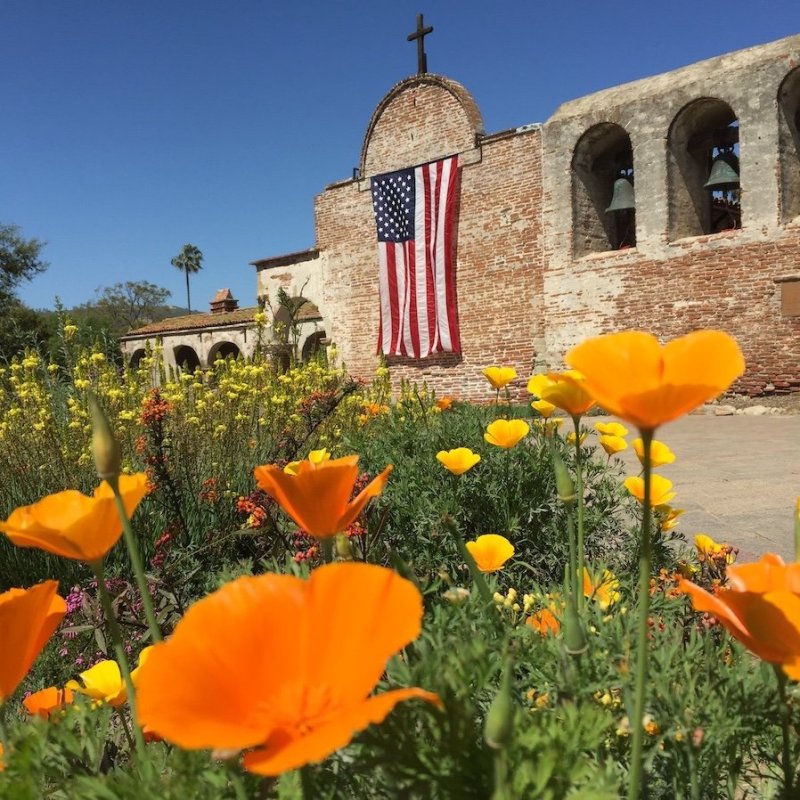
Mission San Juan Capistrano
On Friday, March 19, the Mission San Juan Capistrano officially celebrated both its reopening to the public and the annual return of the swallows. After two extended closures during the past year, the Mission is once again open for guests to explore.
Videos by TravelAwaits
Considered the Jewel of the Missions, Mission San Juan Capistrano was founded in 1776 by Father Junipero Serra as the seventh of 21 California missions established by the Spanish. Its purpose was to expand the territorial boundaries of Spain while also spreading Christianity to the native peoples of California. In 1812 a major earthquake resulted in the destruction of the Great Stone Church on the mission’s property, and subsequently, a long, slow decline began. After spending many years in private hands, the mission was finally returned to the Catholic Church in 1850. Today it is part of the Roman Catholic Diocese of Orange.
Clery, staff, volunteers, and community members have spent decades raising funds to preserve the Mission and restore its buildings and artworks. In 2005 the Mission San Juan Capistrano became the first mission in California with an in-house Preservation Team comprised of full-time professionals with backgrounds in the field of conservation, preservation, and historic site management. This team has worked on several major projects including extensive restoration of both paintings and the altarpiece in Serra Chapel. As the only remaining chapel in California where Father Junipero Serra officiated, it is one of the most historically significant chapels in the state. Preservation efforts are also apparent in other parts of the Mission including the Ruins of the Great Stone Church and the bell wall.

Wendy Lee
The Mission San Juan Capistrano has become known around the world for its annual event, The Return of the Swallows, which takes place on March 19 — also known as St. Joseph’s Day. Swallows migrate 6,000 miles from Goya, Argentina, to San Juan Capistrano in large groups. According to legend, Father St. John O’Sullivan — Pastor of the Mission from 1910-1933 — intervened when a local shopkeeper tried to rid his eaves of the swallows’ nests. He instead invited the swallows to nest at the mission, which they did the very next day. Today the swallows tend to nest in the nearby creek, but they can occasionally be seen flying throughout the Mission grounds.
Typically the swallows’ return is celebrated by large festive events at the Mission and a parade through town featuring horses, bands, and dance troupes. This year, in-person celebrations were scaled back, and the parade canceled, but virtual events were added. In-person events included a welcome by the Executive Director, Mechelle Lawrence, and a traditional ringing of the bells. The official bell ringer positions have only been occupied by a handful of men since the late 1800s. Today the bells were rung by Michael Gastelumm and Nathan Banda. The two smaller bells are the originals cast in Spain, while the two larger bells were duplicates of the originals.
Newly created virtual events were an opportunity for people around the world to learn about the mission and the swallows, hear the historic bells ring, and even take a tour. While the past year has been challenging for the Mission, the introduction of virtual events has significantly expanded their audience.

Mission San Juan Capistrano
In honor of the Year of St. Joseph, Board Member Vicki Carabini and the Italian American Museum of Los Angeles will present a St. Joseph’s Day Table, a large altar of food, often including bread in traditional shapes. This tradition was started in the homes of Sicilians and was later expanded to churches and eventually Italian American communities in the United States. This table will also serve as a fundraiser for the Serra Pantry, a local food bank.
The Mission was reopened on February 4 after experiencing two extended closures over the past year. Financially, the impact of the closures was severe due to the significant drop in school groups and daily visitors. However, staff responded quickly with creativity, and a virtual field trip program was created. While the traditional field trips are offered to schools within a two-hour drive time, the new virtual program has been offered to schools throughout California, and to date over 28,000 children have participated. Recently, a school in Canada participated in one of the tours! Mechelle Lawrence anticipates that these new virtual tours will continue making the Mission accessible to far more schools.

Mission San Juan Capistrano
The repeated closures and managing the new COVID regulations has been difficult for the Mission’s staff and volunteers, but a bright spot was a letter recently received by Mechelle Lawrence from a community member. It read, “If ever there was a time when we’ve needed a beautiful and meaningful place to go, this is it. Thank goodness Mission San Juan Capistrano has opened its doors!”
Currently the Mission is open for visitors Thursday through Sunday from 9 a.m. to 4 p.m. Admission includes an audio tour that helps guests explore the grounds while learning about the Mission’s history. Guests are asked to bring their own drinking water, wear masks, and practice social distancing at all times. For more inspiration on spending time in the area, consider How To Spend A Perfect Day In Beautiful San Juan Capistrano.
